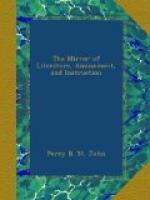THE DRAMATIC ANNUAL.
Mr Frederick Reynolds, the veteran dramatist, has, by the aid of Mr. W.H. Brooke, produced an amusing and elegant volume of a Playwright’s Adventures, under the above title, Mr. Brooke’s contributions are a plentiful sprinkling of Cuts, full of point and humour, and dovetailed by the Editor with no lack of ingenuity. The Narrative itself purports to be a series of adventures, or a volume of accidents to a young playwright in quest of dramatic fortune, with a due admixture of love and murder, and “a happy union.”—These are relieved by pungent attempts at repartee and harmless raillery, so as to make the dialogue portion glide off pleasantly enough. Instead of quoting an entire chapter from the volume, we are enabled to transfer to our pages a few of its epigrammatic illustrations. First, is what Mr. Reynold calls l’auteur siffle, but this, for the sake of comprehensiveness, we style the damned author.
[Illustration: THE DAMNED AUTHOR.]
* * * * *
Mr. Reynolds seems to hold with Swift, that the merriest faces are in mourning coaches, for his hero at a funeral introduces one of the best cuts. Thus—
On Vivid’s return home, his gratification was soon diminished by the recollections of “existing circumstances,” and these caused him to sink into a gloomy and desponding state; when Sam Alltact, rather malapropos, entered with a black-edged card, inviting his master to the funeral of a deceased acquaintance, an eminent young artist, named Gilmaurs, who, never having been an R.A., but simply an engraver of extraordinary genius, was not to be buried under the dome of St. Paul’s, but in a village churchyard.
[Illustration: THE HANGING COMMITTEE.]
Vivid could not help remarking to a brother mourner, that, in his opinion, the profession of a painter was as much overrated as that of an engraver was underrated: “for,” he added, “what real and unprejudiced connoisseur, while contemplating Woollett’s Roman Edifices from Claude, and Sir Robert Strange’s Titian’s Mistress from Titian, with many others, would not acknowledge, that the copy in many instances so rivalled, if not surpassed, the original, that it became a decided question, which artist ought to carry off the palm?”
“Or, at any rate,” cried an odd accordant theatrical companion, “the connoisseur might say, with Shakspeare—
‘Which is the merchant here, and which the Jew?’”
“There is no doubt, that in any school of painting,” continued our hero, “such men as Reynolds, West, and Lawrence, cannot be too much upheld whilst living or lauded and regretted when dead. There is likewise Wilkie—another Hogarth——”
“I beg your pardon,” rejoined the theatrical gentleman; “but till I can forget the blunderbuss fired from the upsetting coach, the cobweb over the poor’s-box, and the gay parson and undertaker at the harlot’s funeral, I cannot allow of the comparison. Besides, I admire Hogarth for another reason: did he consider an engraver’s to be an infradig. profession? No, for he was the engraver of his own works.”




